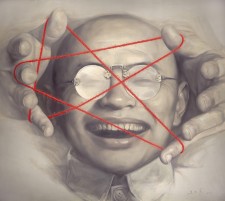Watercolor af a boy and his dog.
Zheng Zhiming was born in Shanghai in 1963 and his elder brother, Zheng Zhiyue, whom had meanwhile emigrated to the USA, inspired his passion for art. Zhiming is presently teaching at the Shanghai Liuhaisu Art and Design Academy and is a member of the Chinese National Artists Association. Today, he is an influential painter in China. His classic Chinese-style furnished home is in Shanghai, where he lives with his wife and only child. Per annum, only a good dozen works will receive his consent to be released onto the market. He visits Tibet, sometimes twice a year, where he gathers his inspiration from the nomadic population who live a simple and honest life, unspoiled by modern society or materialism; it is so unique and very different from the rest of China and they hang on to their religious Tibetan traditions.
As a young talent he started out as a gifted draughtsman, publishing over twenty picture-story books, for which he has been frequently awarded.
In 1995 and 1996, he and his brother held joint exhibitions of ‘Golden Tibet Oil Painting and Watercolour’ in a New York art gallery.
In 1996 he was awarded the silver medal in the Chinese National Exhibition of Watercolour and Water powder Painting for his work “Little Buddhist Monk”. In later years Zheng Zhiming exhibited in Tian Jin and Beijing, and participated with his work “Mother and Son” in the Fifth World Exhibition of Watercolour Painting in Taiwan.
Awards of Excellence followed, including a joint exhibition in the China Art
Museum. And recently, his large watercolour “A Message from Far Away” won the Grand Award at the 2006 Shanghai Art Exhibition. Ever since, he has become a sought-after artist whose scarce work is usually bought directly from his studio.
To be able to admire and purchase his fine and monumental water-colours in Europe is seen as a rare opportunity to have a glimpse into a pure and unique culture: a window of chance!
Zheng Zhiming is an energetic influential painter, yet lives a private genuine lifestyle. His early drawing technique laid a solid foundation for his future subject modeling. He subsequently became a skillful oil painter but his vivid watercolours attract most attention. He has affection for painting herdsmen, women and children within their own environment and with a purified spirit, which is not yet corroded by modern society, financial gain or any materialistic desire.
He favours realism in his work but this by no means reflects any technical form of colour photography. During his travels to Tibet he filled many a sketchbook with his realistic and skillful sketches before working out his powerful watercolours. In this, he preserves the characteristics of traditional watercolour painting. His portrayals are vivid and smooth, with delicate colouring, not just sweet or rigid, but soft and solid. The golden sunshine of the Tibetan atmosphere is an integral part of the overall subject matter. This subtle tonality even changes its cold and gray moments, showing his inward true love and hope for Tibetan life.
Zheng sums up his experience as follows: “In people’s consciousness the legend Tibet is a wild and secret land, however, she is my true living feeling. The sunshine is so pure, it is not only visible but I can smell and hear and touch it. By way of shining and its reflection, sunlight melts all things together, which leaves a footprint of life. Colour and subject matter show an attractive artistic charm, under hot sunshine.” And he continues: “The originality of nature completely appears on that wild plateau; people’s existence become their primary need followed by their daily desire to be equally common. I highly respect these born natives, and I join them in that same search for life. At least they have not yet gotten rid of their ignorance.”
“Consequently, I devote my search and artistic creation to spiritual world of keeping quiet and calm, trying to find my balance in nature. True painting can express my earnest feeling for life and livelihood.
The changeability of the medium watercolour endows me with limitless imagination portraying ‘jumping’ sunshine.
When working with watercolour, I demand myself to be quiet, very meti-culous and to get something done without distraction. Each work is not only a genuine personal experience, but also a firm step on my road of artistic creation. I create work in accordance with realism in life, with a true subject matter and realistic representation and I’d like to pursue simplicity and nature reducing any artificiality. Only this can truly reflect the essential vitality of Tibetan people.”
And about his way of working, Zheng shares the following: “In the context of painting a young woman doing her housework leisurely, while children are standing nearby with their heads lowered or leaning against a fence, staring, the sunshine only illuminates the outlines emphasizing a zest for life. During these moments, the external reality to life is no longer important, and the highlights in the overall subject matter become the spirit of the Tibetan’s continuous progress. They love living.
The application of yellow, green and red play an actual role in colour and creation. A fresh and bright atmosphere transmit my wholehearted praise for the great strength of the Tibetan people’s soul.”
“The world is a great place. Strangely enough though, different people attest their own existence during different modes of life. The way I create is consequent with the way I try to live my life. To portray realism in life is my work and my love and motivates my life. I believe in working hard and to pursue perfection. I shall face each future sunrise and sunset in a peaceful and firm mood.”


